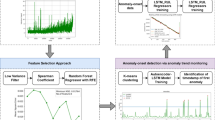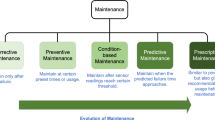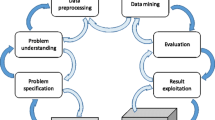Abstract
With the development of sensor and communication technology, industrial systems have accumulated a large amount of data. This data has provided new perspectives and methods for industrial system analysis, monitoring and control, which is proven to be of great significance. However, with the collection and storage of industrial data in a 7 × 24 manner, the computing and information processing capabilities of edge controllers and computers at industrial sites face new challenges. Therefore, this paper proposes a distributed dictionary learning algorithm based on the MapReduce framework. The dictionary learning method can efficiently extract useful information from high-dimensional data for process monitoring. In addition, deploying the algorithm under the MapReduce framework can achieve the purpose of parallel distributed computing, which would solve the issue that the ability of calculation and information processing is limited at industrial sites. Based on extensive numerical experiments, the proposed method can improve the effectiveness and robustness of process monitoring for industrial processes.










Similar content being viewed by others
References
Westerhuis JA, Kourti T, MacGregor JF (1998) Analysis of multiblock and hierarchical pca and pls models. J Chemom 12(5):301–321
Bakshi BR (1998) Multiscale pca with application to multivariate statistical process monitoring. AIChE J 44(7):1596–1610
Navi M, Meskin N, Davoodi M (2018) Sensor fault detection and isolation of an industrial gas turbine using partial adaptive kpca. J Process Control 64:37–48
Liu Q, Qin SJ, Chai T (2014) Multiblock concurrent pls for decentralized monitoring of continuous annealing processes. IEEE Trans Ind Electron 61(11):6429–6437
Dong J, Zhang K, Huang Y, Li G, Peng K (2015) Adaptive total pls based quality-relevant process monitoring with application to the tennessee eastman process. Neurocomputing 154:77–85
Jiang Q, Gao F, Yi H, Yan X (2019) Multivariate statistical monitoring of key operation units of batch processes based on time-slice cca. IEEE Trans Control Syst Technol 27(3):1368–1375
Cheng F, Dong J (2019) Monitoring tip-based nanomachining process by time series analysis using support vector machine. J Manuf Process 38:158–166
Yu J (2010) Hidden markov models combining local and global information for nonlinear and multimodal process monitoring. J Process Control 20(3):344–359
Lee S, Kwak M, Tsui K-L, Kim SB (2019) Process monitoring using variational autoencoder for high-dimensional nonlinear processes. Eng Appl Artif Intell 83:13–27
Ge Z, Song Z (2013) Distributed pca model for plant-wide process monitoring. Indust Eng Chem Res 52(5):1947–1957
Jiang Q, Yan X, Huang B (2016) Performance-driven distributed pca process monitoring based on fault-relevant variable selection and bayesian inference. IEEE Trans Ind Electron 63(1):377–386
Ge Z (2017) Review on data-driven modeling and monitoring for plant-wide industrial processes. Chemometr Intell Lab Syst 171:16–25
Zhu J, Ge Z, Song Z, Zhou L, Chen G (2018) Large-scale plant-wide process modeling and hierarchical monitoring: A distributed bayesian network approach. J Process Control 65:91–106
Huang J, Yan X (2018) Relevant and independent multi-block approach for plant-wide process and quality-related monitoring based on kpca and svdd. ISA Trans 73:257–267
Jiang Q, Huang B (2016) Distributed monitoring for large-scale processes based on multivariate statistical analysis and bayesian method. J Process Control 46:75–83
Zhu J, Ge Z, Song Z (2017) Distributed parallel pca for modeling and monitoring of large-scale plant-wide processes with big data. IEEE Trans Ind Inf 13(4):1877–1885
Xu C, Zhao S, Liu F (2017) Distributed plant-wide process monitoring based on pca with minimal redundancy maximal relevance. Chemometr Intell Lab Syst 169:53–63
Aharon M, Elad M, Bruckstein A (2006) K-svd: An algorithm for designing overcomplete dictionaries for sparse representation. IEEE Trans Signal Process 54(11):4311–4322
Zhou H, Chen J, Dong G, Wang R (2016) Detection and diagnosis of bearing faults using shift-invariant dictionary learning and hidden markov model. Mech Syst Signal Process 72-73:65–79
Peng X, Tang Y, Du W, Qian F (2017) Multimode process monitoring and fault detection: A sparse modeling and dictionary learning method. IEEE Trans Ind Electron 64(6):4866–4875
Bollepalli SC, Challa SS, Anumandla L, Jana S (2018) Dictionary-based monitoring of premature ventricular contractions: An ultra-low-cost point-of-care service. Artif Intell Med 87:91–104
Han T, Jiang D, Sun Y, Wang N, Yang Y (2018) Intelligent fault diagnosis method for rotating machinery via dictionary learning and sparse representation-based classification. Measurement 118:181–193
Huang K, Wu Y, Wang C, Xie Y, Yang C, Gui W (2020) A projective and discriminative dictionary learning for high-dimensional process monitoring with industrial applications. IEEE Trans Ind Inf:1–1
Yang C, Zhou L, Huang K, Ji H, Long C, Chen X, Xie Y (2019) Multimode process monitoring based on robust dictionary learning with application to aluminium electrolysis process. Neurocomputing 332:305–319
Huang K, Wu Y, Yang C, Peng G, Shen W (2020) Structure dictionary learning-based multimode process monitoring and its application to aluminum electrolysis process. IEEE Trans Autom Sci Eng:1–15
Huang K, Wu Y, Wen H, Liu Y, Yang C, Gui W (2020) Distributed dictionary learning for high-dimensional process monitoring. Control Eng Pract 98:104386
Liang J, Zhang M, Zeng X, Yu G (2014) Distributed dictionary learning for sparse representation in sensor networks. IEEE Trans Image Process 23(6):2528–2541
Huang K, Wen H, Ji H, Cen L, Chen X, Yang C (2019) Nonlinear process monitoring using kernel dictionary learning with application to aluminum electrolysis process. Control Eng Pract 89:94–102
Chainais P, Richard C (2013) Learning a common dictionary over a sensor network. In: 2013 5th IEEE International Workshop on Computational Advances in Multi-Sensor Adaptive Processing (CAMSAP), pp 133–136
Sheather S, Jones M (1991) A reliable data-based bandwidth selection method for kernel density estimation. J R Stat Soc Ser B Methodol 53:683–690
Chen G, Liu Y, Ge Z (2019) K-means bayes algorithm for imbalanced fault classification and big data application. J Process Control 81:54–64
Bengfort B, Kim J (2016) Data analytics with hadoop. O’Reilly Media, Inc.
Yin S, Ding SX, Haghani A, Hao H, Zhang P (2012) A comparison study of basic data-driven fault diagnosis and process monitoring methods on the benchmark tennessee eastman process. J Process Control 22(9):1567–1581
Li G, Qin SJ, Ji Y, Zhou D (2010) Reconstruction based fault prognosis for continuous processes. Control Eng Pract 18(10):1211–1219
Ghaffari V, Naghavi SV, Safavi AA (2013) Robust model predictive control of a class of uncertain nonlinear systems with application to typical cstr problems. J Process Control 23(4):493–499
Wu F (2001) Lmi-based robust model predictive control and its application to an industrial cstr problem. J Process Control 11:649–659
Bathelt A, Ricker NL, Jelali M (2015) Revision of the tennessee eastman process model. IFAC-PapersOnLine 48(8):309–314. 9th IFAC Symposium on Advanced Control of Chemical Processes ADCHEM 2015
D’Angelo MFSV, Palhares RM, Filho M COC, Maia RD, Mendes JB, Ekel PY (2016) A new fault classification approach applied to tennessee eastman benchmark process. Appl Soft Comput 49:676–686
Acknowledgments
This work was supported in part by the the National Key R&D Program of China (2019YF- B1705300), the National Natural Science Foundation of China (Grant Nos. 61860206014), in part by the Innovation-Driven Plan in Central South University (2019CX020), and in part by the 111 Project (B17048).
Author information
Authors and Affiliations
Corresponding author
Additional information
Publisher’s note
Springer Nature remains neutral with regard to jurisdictional claims in published maps and institutional affiliations.
Rights and permissions
About this article
Cite this article
Huang, K., Wei, K., Li, Y. et al. Distributed dictionary learning for industrial process monitoring with big data. Appl Intell 51, 7718–7734 (2021). https://doi.org/10.1007/s10489-020-02128-x
Accepted:
Published:
Issue Date:
DOI: https://doi.org/10.1007/s10489-020-02128-x




